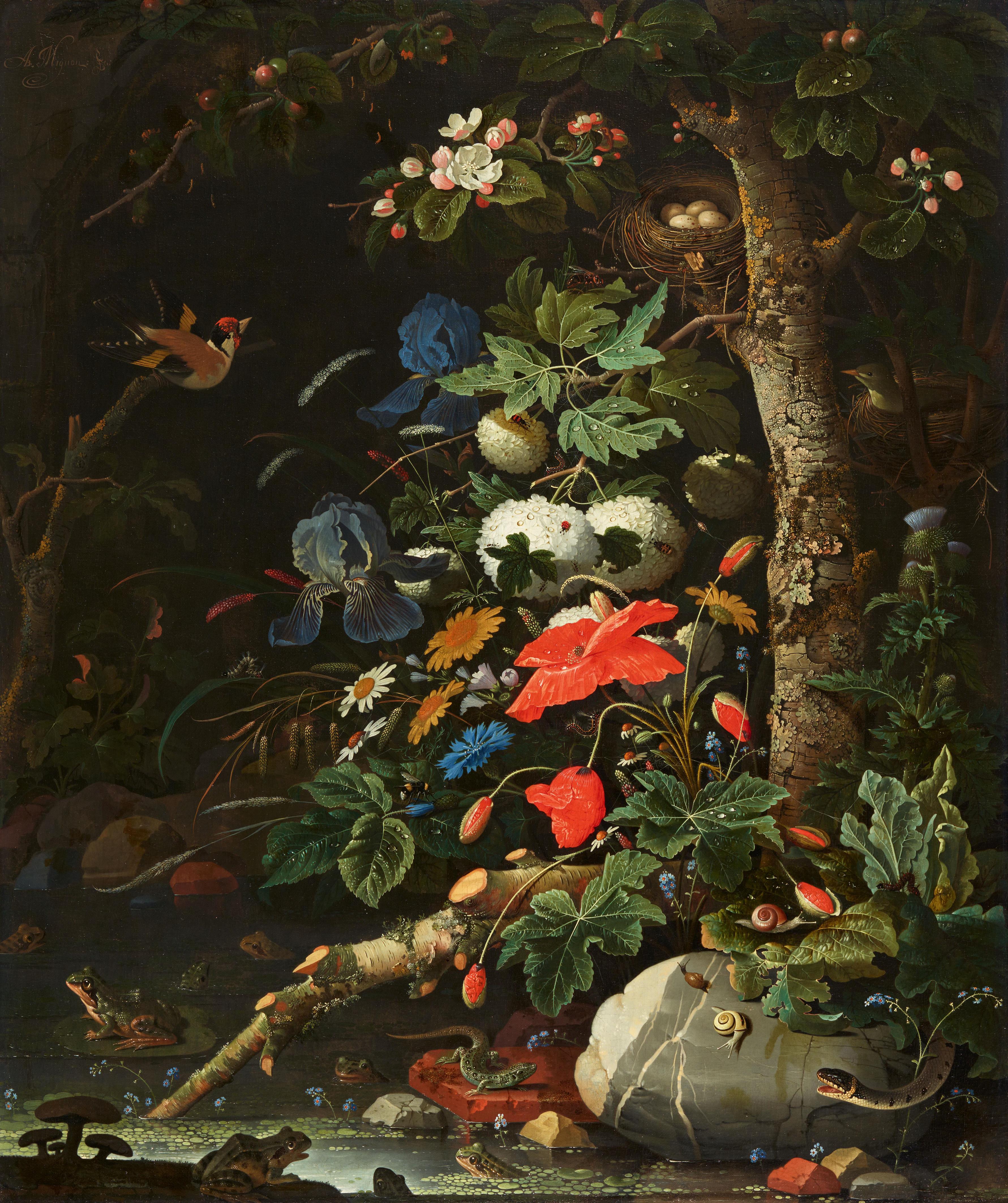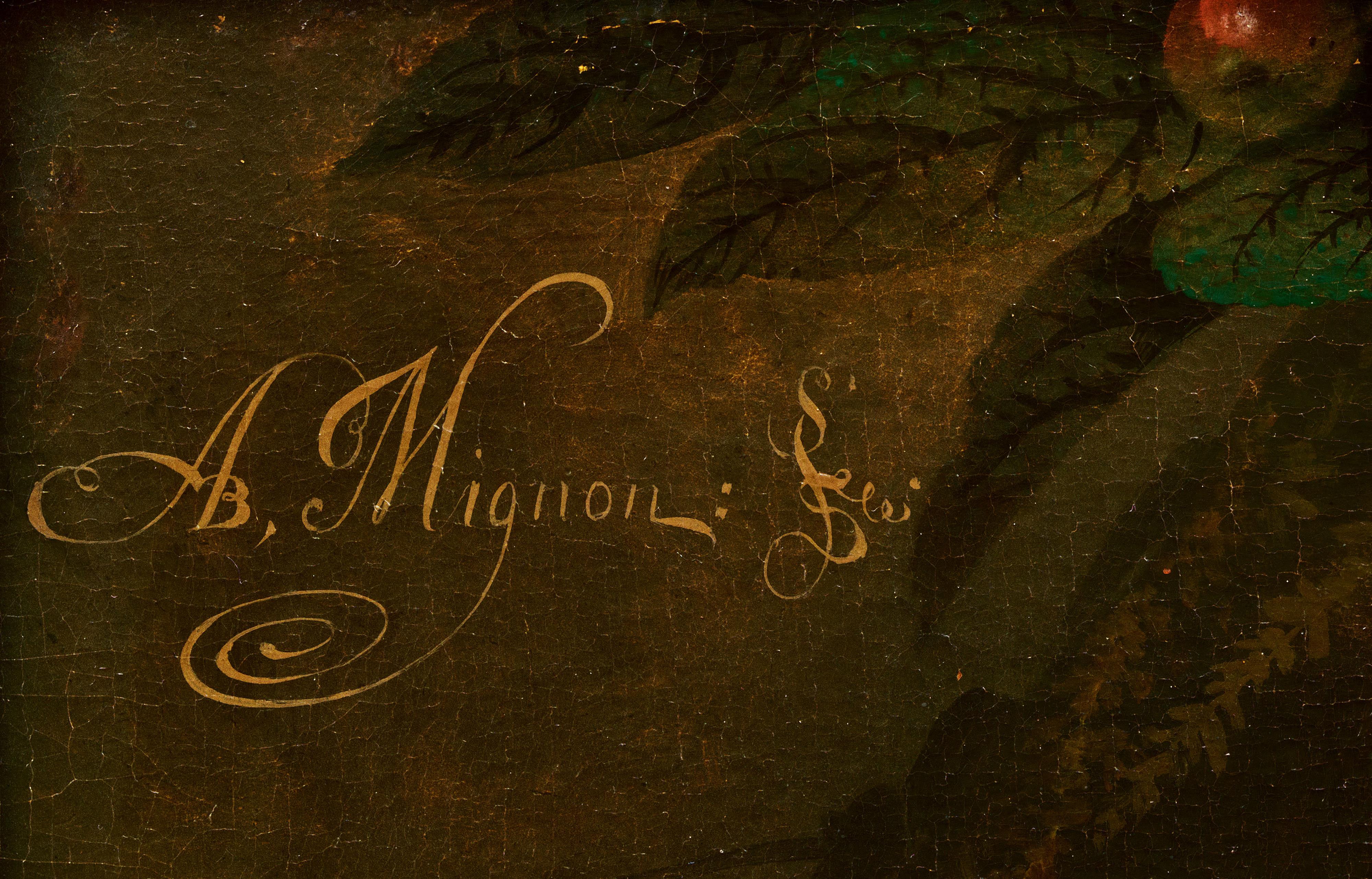Abraham Mignon
Flowers in a Forest Landscape
Oil on canvas (relined). 73 x 60 cm.
Signed upper left: AB. Mignon fec. (AB in ligature).
Arnold Houbraken wrote his collection of biographies of Dutch artists, the "Groote schouburgh der Nederlantsche konstschilders en schilderessen", at the beginning of the 18th century, looking back on a golden age of art. In it, Houbraken did not fail to acknowledge immediately at the beginning the contribution of artists from foreign countries who had come to the Netherlands from "Germany, Switzerland, the Jülich region, the Cologne region" to enrich Dutch art; artists such as Caspar Netscher, Govaert Flinck, Johannes Lingelbach - and Abraham Mignon from Frankfurt.
Utrecht, a leading centre of Dutch still life painting, and the imperial city of Frankfurt were the main geographical fixed points in the impressive but short career of Abraham Mignon, who owed his melodious French name to ancestors from the Hainaut region. Jacob Marell and Jan Davidsz. de Heem, in turn, were the artistic reference points in his oeuvre, which he devoted entirely to still-life painting. Probably in 1649, when he was barely ten years old, he apprenticed in Frankfurt to Jacob Marrell, a pupil of Georg Flegel with close artistic connections to Utrecht. In 1659 Mignon and Marrel were on their way to Utrecht together, and one year later we find Mignon in the workshop of the leading master of the field, Jan Davidsz. de Heem (cf. lot 1564), whose still lifes of flowers and fruits would become formative for him. When de Heem moved to Antwerp in 1672, Abraham Mignon probably took over his workshop. Mignon died in 1679, when he was only 40 years old, which explains the small number of 69 paintings by his own hand in the catalogue raisonné. According to Kraemer-Noble, the present work, which has been in German family ownership for over 40 years, is one of the artist's masterpieces in which the signature is uncontested (Kraemer-Noble 2007, op. cit., p. 224f, no. 88).
The work depicts a forest floor still life. Flowers of various colours and shapes grow in the shade of an apple tree: Daisies, irises, Cyprus grass, field poppies, and camomile sprout from the ground, like fireworks the petals shine out in red, blue, yellow and white, accompanied by the green of the serrated and toothed leaves. The term still life actually seems inappropriate for this picture, in which so many insects, small animals and birds flutter, hop and crawl. Beetles and bees sit on the flowers and leaves, a goldfinch flies to its nest, snails, lizards and frogs squat on the stones, some of the frogs swim in the water that covers almost the entire front of the painting, so even the description "forest floor" seems less than suitable. The piece presents a colourful microcosm at the foot of a tree, secluded from civilisation.
In this forest floor still life, Abraham Mignon takes up a genre popularised in the Netherlands by artists such as Otto Marseus van Schrieck and Mathias Withoos. Mignon's composition is ostentatiously artificial; it is an artfully arranged imitation of nature. Here Mignon shows all his mastery in composition as well as in the rendering of different materials, which also characterise his flower and fruit still lifes. The diagonal composition of the magnificent flowers that dominates the picture is accompanied by the zigzag of the animals' glances and movements, for example the way in which the goldfinch flies to its nest, the frog looks at the snake or the salamander creeps towards the snails. Mignon's skill is also evident in the closely observed and precisely rendered surface textures of the animals and objects: the nuanced light brown of the thin branches from which the bird's nest is built; the clear drops of water on the flowers and leaves; the green-ochre oscillation of the bark and the glittering dark green of the moss; the yellow, grey, and red stones whose grain and weathering are made real before the viewer's eyes. Kraemer-Noble compares this work to forest floor still lifes by Mignon now in the Bayerische Staatsgemäldesammlungen in Ansbach (inv. 1645) and the Smith College of Art in Northhampton, MA (inv. no. 1957:3), which are similar in format, composition and design of the scenery (Kraemer-Noble 2007, op. cit., pp. 220-224).
Provenance
Count Grégoire Stroganoff, Nemiroff Castle, Western Russia/Rome, ca. 1911. –Bob Smith Collection, Washington D.C. – Julie Kraus Galerie, Paris, 1978. – Thence in German private collection.
Literature
Pictures in the Stroganoff Collection, Rome, in: Revue d´art Starje-Gody, St. Petersburg 1909. – A. Munoz: Pièce de choix de la collection du Comte de G. Stroganoff, Rom 1911, p. 91, plate LXXII. – Thieme-Becker XXIV, S. 548. – Magdalena Kraemer-Noble: Abraham Mignon, Leigh-on-Sea 1973, Nr. A60, Abb. 35. - Magdalena Kraemer-Noble: Abraham Mignon 1640-1679, catalogue raisonné, Petersberg 2007, p. 224-225, no. 88.




